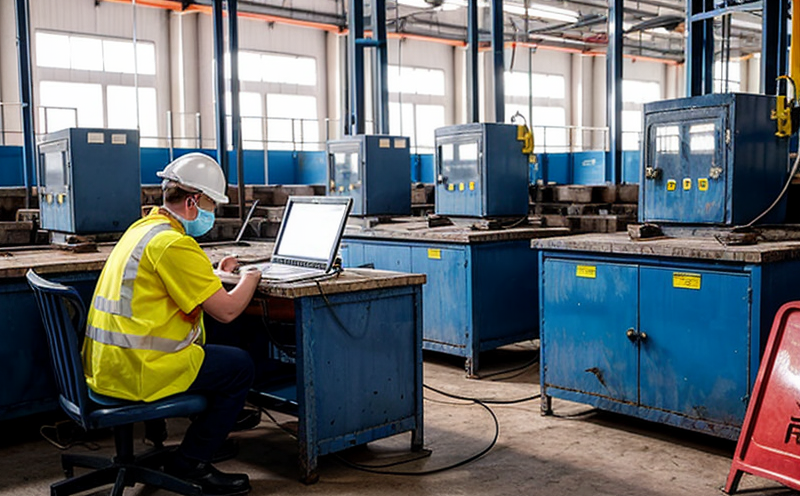ISO 13850 Emergency Stop Device Testing in Factories
The implementation of ISO 13850 emergency stop (ES) device testing is critical to ensuring occupational health and safety within industrial manufacturing environments. This standard, developed by the International Organization for Standardization, focuses on the design, construction, installation, and maintenance of ES devices used in machinery and equipment.
Emergency stop devices are essential components designed to prevent accidents and injuries caused by unexpected or unintended machine movements. They play a pivotal role in safeguarding workers from hazards such as entanglement, impact, and crushing. In compliance with ISO 13850, factories must ensure that their ES devices meet stringent requirements for performance, reliability, and safety.
The testing process involves several key steps to verify the functionality of these critical safety systems. These tests are conducted using specialized equipment tailored to simulate real-world conditions under which an ES device might be activated. Testing typically includes:
- Functionality checks to ensure immediate shutdown upon activation
- Voltage and current stability tests to prevent power fluctuations during emergency situations
- Load testing to evaluate the device's ability to handle unexpected loads without failure
- Environmental condition assessments, including temperature and humidity effects on performance
- Compatibility checks with other safety devices in the machinery system
The purpose of these tests is to identify any potential flaws or weaknesses that could compromise worker safety. By adhering strictly to ISO 13850 guidelines, factories can ensure their ES systems are robust and reliable.
| Test Parameter | Description |
|---|---|
| Activation Time | The time taken for the ES device to activate and bring the machine to a complete stop. |
| Reset Functionality | The ability of the system to return to normal operation after reset. |
| Load Capacity | The maximum load capacity the ES device can handle without failure. |
| Environmental Resistance | Testing for resistance to environmental factors such as dust, humidity, and temperature variations. |
In addition to these physical tests, a thorough review of the design specifications and installation documentation is conducted. This ensures that all safety features are correctly implemented according to ISO standards. Regular maintenance checks are also performed to verify ongoing compliance with the standard.
The importance of ISO 13850 cannot be overstated in today’s industrial landscape where worker safety remains a top priority. By implementing these stringent testing protocols, factories not only meet regulatory requirements but also enhance their reputation as responsible and forward-thinking organizations committed to occupational health and safety.
Scope and Methodology
The scope of ISO 13850 emergency stop device testing encompasses a comprehensive evaluation of the device’s performance, reliability, and compliance with international standards. This includes:
- Evaluation of all safety functions to ensure they operate correctly under normal conditions
- Testing for the ability to withstand environmental factors that may affect performance
- Verification of compatibility with other safety devices in the machinery system
- Assessment of maintenance procedures and records to ensure ongoing compliance
The methodology employed for these tests is meticulous and involves a series of steps:
- Initial inspection of the device’s design, construction, and installation documentation.
- Conducting functional tests to verify immediate shutdown upon activation.
- Loading the system with simulated loads to test its capacity under stress.
- Subjecting the ES device to environmental conditions that simulate real-world usage.
- Performing a final inspection and documentation of all findings.
The results of these tests are meticulously recorded and reviewed by qualified personnel. Any discrepancies or non-compliance issues are addressed immediately, ensuring strict adherence to ISO 13850 standards.
International Acceptance and Recognition
ISO 13850 emergency stop device testing is widely recognized across the globe for its stringent requirements and comprehensive approach to safety. Some key points of international acceptance include:
- The standard has been adopted by numerous countries with robust manufacturing sectors.
- Many regulatory bodies worldwide reference ISO 13850 in their guidelines for machinery safety.
- International organizations such as the International Labour Organization (ILO) and the World Health Organization (WHO) recommend compliance with this standard to ensure occupational health and safety.
The widespread acceptance of ISO 13850 is a testament to its effectiveness in enhancing worker safety. Compliance with this standard not only ensures regulatory adherence but also fosters a safer working environment, which can lead to increased productivity and reduced insurance costs for factories.
Competitive Advantage and Market Impact
Incorporating ISO 13850 emergency stop device testing into your quality management system provides several competitive advantages:
- Enhanced Reputation: Demonstrating compliance with international standards can significantly enhance the reputation of a factory as a responsible and safety-conscious organization.
- Increased Safety: A safer working environment translates to reduced accidents, injuries, and associated costs.
- Better Compliance: Ensuring strict adherence to regulatory requirements helps avoid potential fines and penalties.
- Improved Productivity: By eliminating safety risks, factories can maintain a steady production flow without interruptions.
- Customer Trust: Demonstrating commitment to worker safety can build trust with customers and stakeholders.
The market impact of ISO 13850 compliance is profound. Factories that implement this standard are better positioned to attract investments, secure contracts, and expand their operations. In an increasingly competitive global market, adherence to international standards like ISO 13850 can be a key differentiator.





